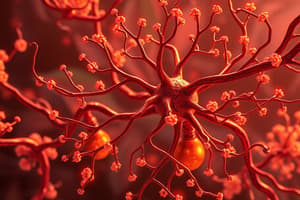Podcast
Questions and Answers
Where are nicotinic acetylcholine receptors found?
Where are nicotinic acetylcholine receptors found?
- Only in the central nervous system
- Central and peripheral nervous system, muscle, and many other tissues (correct)
- Limited to the neuromuscular junction
- Exclusively in the immune system
What is the primary function of nicotinic receptors at the neuromuscular junction?
What is the primary function of nicotinic receptors at the neuromuscular junction?
- Transmit outgoing signals within the sympathetic and parasympathetic nervous system
- Control muscle contraction (correct)
- Receive acetylcholine released to signal for muscular contraction
- Regulate inflammatory processes
Why are nicotinic receptors considered cholinergic receptors?
Why are nicotinic receptors considered cholinergic receptors?
- Because they are limited to the central nervous system
- Because they respond to acetylcholine (correct)
- Because they are found in the immune system
- Because they selectively bind to muscarine
Which type of transmission involves the release of high concentrations of neurotransmitters acting on immediately neighboring receptors?
Which type of transmission involves the release of high concentrations of neurotransmitters acting on immediately neighboring receptors?
What can cause a desensitized receptor to revert to a prolonged open state?
What can cause a desensitized receptor to revert to a prolonged open state?
How many vertebrate nAChR subunits have been identified?
How many vertebrate nAChR subunits have been identified?
What is the function of neuronal forms of the nicotinic receptor found pre-synaptically?
What is the function of neuronal forms of the nicotinic receptor found pre-synaptically?
Which subunits are included in muscle-type nicotinic acetylcholine receptors?
Which subunits are included in muscle-type nicotinic acetylcholine receptors?
What effect does the binding of an agonist like nicotine have on nicotinic acetylcholine receptors?
What effect does the binding of an agonist like nicotine have on nicotinic acetylcholine receptors?
What is the role of snake venom neurotoxins in relation to nicotinic acetylcholine receptors?
What is the role of snake venom neurotoxins in relation to nicotinic acetylcholine receptors?
Flashcards are hidden until you start studying
Study Notes
Nicotinic Acetylcholine Receptors: Structure, Binding, and Effects
- Nicotinic acetylcholine receptors (nAChRs) can use second messengers like metabotropic receptors
- Nicotinic receptors transmit outgoing signals for sympathetic and parasympathetic systems
- Receptors can be antagonized by compounds like hexamethonium, interfering with signal transmission
- Nicotinic receptors have a molecular mass of 290 kDa and are made up of five subunits arranged around a central pore
- Nicotinic receptors are broadly classified into muscle-type and neuronal-type based on their primary sites of expression
- Muscle-type receptors are composed of α1, β1, γ, and δ subunits, while neuronal subtypes include various homomeric or heteromeric combinations of twelve different subunits
- Binding of a chemical messenger like acetylcholine or agonists like nicotine or epibatidine is necessary for opening the nAChR channel pore
- Nicotinic AChRs may exist in different conformational states, and binding of an agonist stabilizes the open and desensitized states
- The channel allows positively charged ions to move across it, with a net flow of positively charged ions inward
- Many neuronal nAChRs can affect the release of other neurotransmitters
- The activation of receptors by nicotine modifies the state of neurons through depolarization of the plasma membrane and entry of calcium, leading to the activation of voltage-gated ion channels and intracellular cascades
- Snake venom neurotoxins antagonistically bind to nAChRs, inhibiting ion flow and leading to paralysis and death
Studying That Suits You
Use AI to generate personalized quizzes and flashcards to suit your learning preferences.




